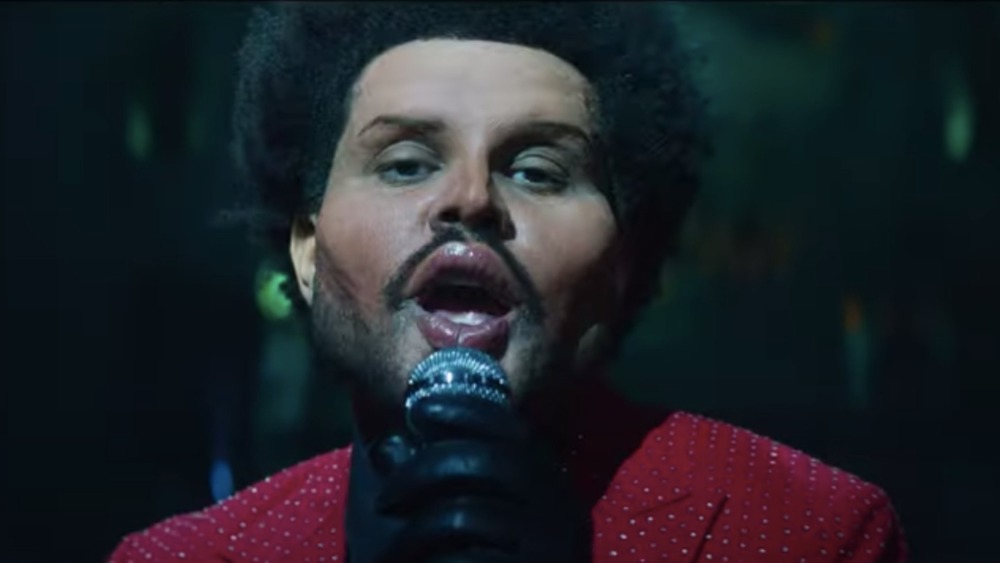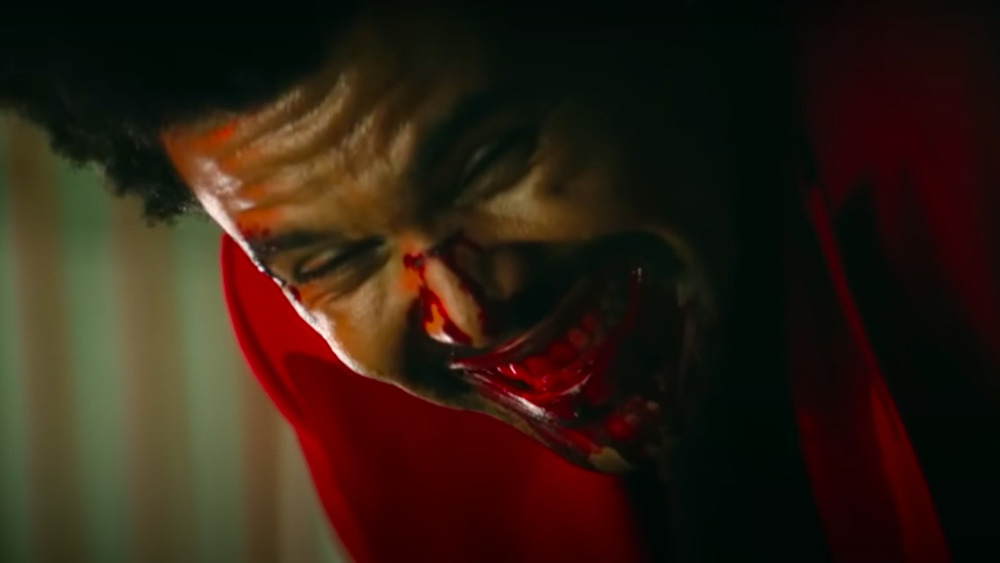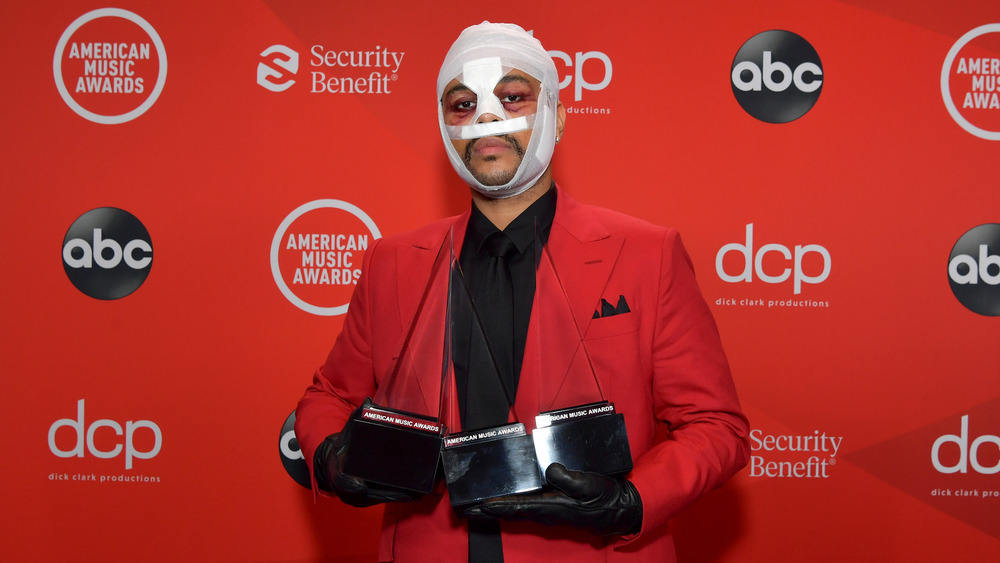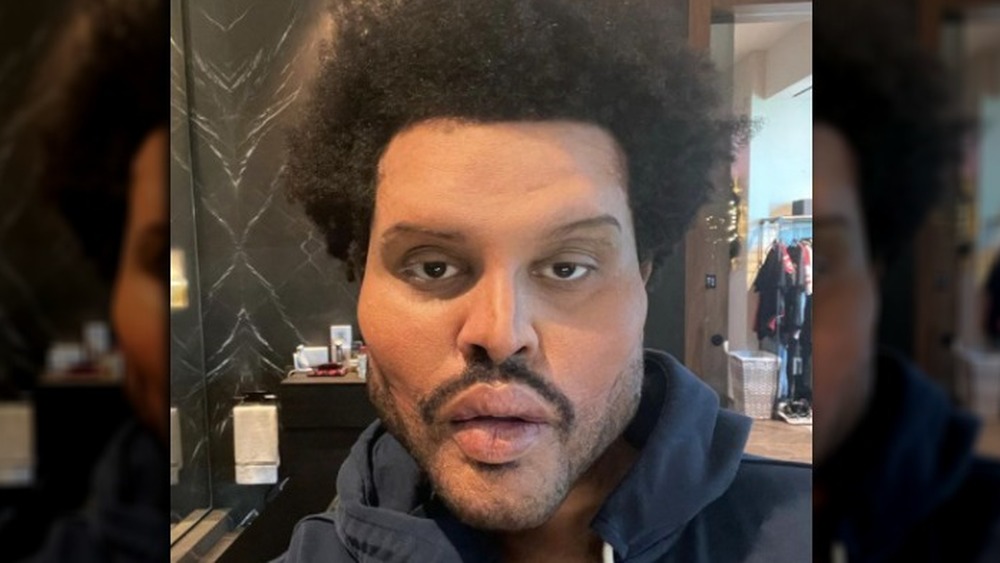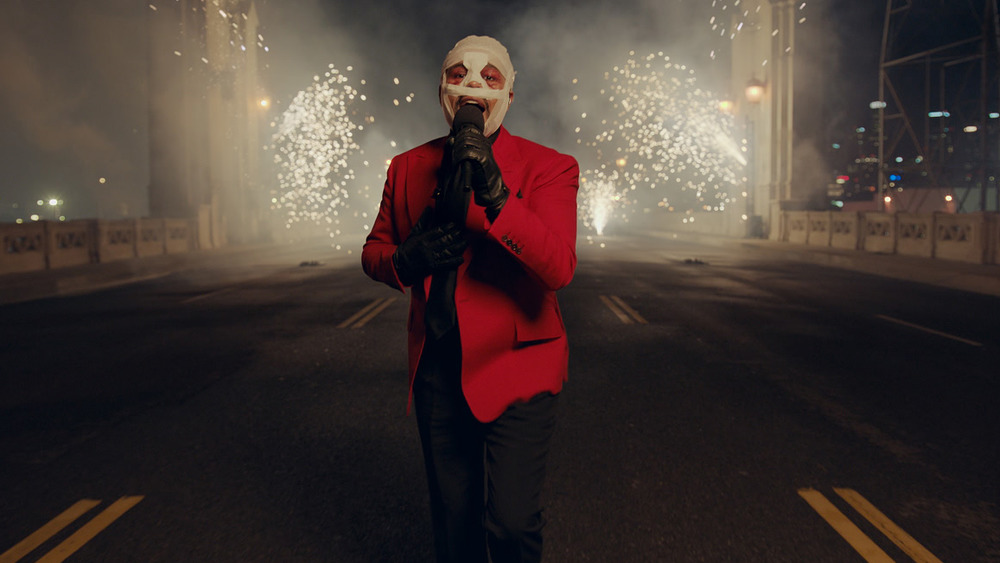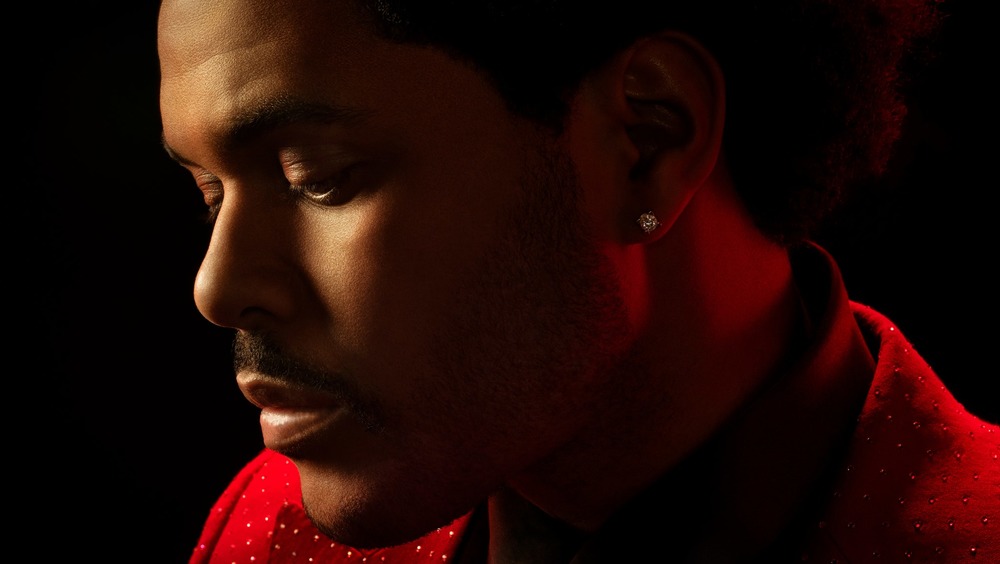What's Really Going On With The Weeknd's Face?
The Weeknd is looking rough these days. Since before the release of his fourth studio album After Hours in March 2020, the chart-topping pop/R&B singer's appearance has become as disturbing as the sordid tales of sex, drugs, and soul-numbing misery he describes in hit songs like "Can't Feel My Face" and "The Hills." In live performances, music videos, and even on After Hours' album cover, his face has been made up to look bloodied and/or bandaged, though more recently he's shifted to looking like he's had plastic surgery that's gone terribly wrong. No, he hasn't actually gotten surgery to look like a nightmare version of Handsome Squidward, but the whole truth about what he's really up to does remain pretty mysterious.
The Canadian singer — whose real name is Abel Tesfaye — has experimented with provocative visuals going back to the nudity on the cover of his debut 2011 mixtape House of Balloons, but his current violent performance art piece takes it to a new level, both for how grotesque it is and for how long it's been going on. He debuted his bloody look in January 2020, with the music video for his Billboard Hot 100 #1 single "Blinding Lights" and a striking performance on Jimmy Kimmel Live, where he had a bandage across his nose and blood dripping down his face. Since then, the weirdness has only escalated, and it's expected to reach its peak when he headlines the Super Bowl LV halftime show on Feb. 7.
Here's everything we know about what's going on with The Weeknd's face, including the history of his look and who's doing his makeup.
The story started in The Weeknd's music videos
The Weeknd's After Hours era has been about more than the music, as the album has been accompanied by a distinct, consistent aesthetic. The Weeknd has worn the same red jacket throughout the album's rollout, and the disorienting visuals call to mind movies like Fear and Loathing in Las Vegas (the video for "Heartless" is a psychedelic trip through Sin City), Joker (in "Blinding Lights," Tesfaye manically dances like Arthur Fleck), and Uncut Gems, a film in which The Weeknd appeared as a fictionalized version of himself and from which he appears to have borrowed his bandages from Howie Ratner (Adam Sandler).
Each music video for the album's singles has found him sporting a slightly different look. In the video for the first single, "Heartless," he looks pretty normal. The blood starts in "Blinding Lights," and the bandages show up in a promotional short film, "In Your Eyes" and "Until I Bleed Out." The animated video for "Snowchild" is a little bit different, taking a look backward at the first decade of his career, but his nose is bandaged in the After Hours parts. "Too Late" puts the bandages on a pair of women who just got plastic surgery. The most recent video, "Save Your Tears," introduces a new look — excessive plastic surgery on The Weeknd himself.
The videos tell a loose narrative about a character, played by The Weeknd, spiraling deeper into violence and madness. They've been bridged by The Weeknd's live performances, which share the dark aesthetic.
What The Weeknd's bandages might mean
The Weeknd was bloody and bandaged in his initial Kimmel performance, and followed that by looking beat up on Saturday Night Live and the MTV VMAs. Then he really freaked people out with his mummy-like bandages at the American Music Awards. At that award show, he performed a medley of his hits and accepted the award for Favorite Album – Soul/R&B looking like he'd either been in a car accident or had gotten facial surgery, and dedicated the award to the late superstar Prince, who he said was the reason he was able to challenge the genre definitions and aesthetic rules of R&B.
After the AMA appearance, Elle made a connection between the bandages and a quote The Weeknd gave to Esquire in an interview earlier in 2020, claiming that the bandages were an anti-drunk driving message showing the consequences of what can happen if one drives while under the influence. "'Blinding Lights' is about how you want to see someone at night, and you're intoxicated, and you're driving to this person and you're just blinded by streetlights. But nothing could stop you from trying to go see that person, because you're so lonely," he told Esquire. "I don't want to ever promote drunk driving, but that's what the dark undertone is."
But Elle's explanation seems unlikely, considering The Weeknd's immoral persona and the fact that the next evolution of his look was "plastic surgery disaster." This explanation got picked up by media outlets including the BBC, but the truth is that The Weeknd has never said what his aesthetic means.
The Weeknd's prosthetic makeup is from one of the greats
The plastic surgery look of "Save Your Tears" is prosthetic makeup created by Mike Marino of Prosthetic Renaissance, a New Jersey-based special effects makeup studio that has done work for movies including The Irishman, Joker, and Coming 2 America. Prosthetic Renaissance has done all of the Weeknd's makeup effects during the After Hours era, but the plastic surgery face is the newest and most ambitious. The makeup is a four-piece prosthetic appliance. The studio's Instagram account recently posted a behind-the-scenes look at the creation of the prosthetics.
The Weeknd's transformation is similar to a performance art project by drag performer and makeup artist Alexis Stone, who according to Allure did a months-long project in 2018 where he applied prosthetics and claimed he had gotten extensive plastic surgery. Stone cast a sideways glance at the singer on Instagram, posting photos comparing The Weeknd's plastic surgery look with his own captioned with the comment "nice concept" and the puzzled face emoji. It's not an outright accusation that The Weeknd stole the idea, but that's the implication, even though The Weeknd's appearance and artistic ends are quite different from Stone's: Stone was trying to fool his Instagram followers and draw attention to social media cruelty, while The Weeknd seems to be satirizing Hollywood culture. Plus, it doesn't seem the Weeknd was ever attempting to convince anyone he'd actually undergone plastic surgery.
What will The Weeknd look like at the Super Bowl?
The big question is whether or not The Weeknd will bring his performance art project to the biggest stage a musician can have in America — the Super Bowl halftime show. The Weeknd will follow in the footsteps of his inspiration, Prince, and headline this year's big game. It would be a bold move to take the stage in front of approximately a hundred million viewers on Feb. 7 with bloody bandages hiding his face, and it's unknown if he's actually going to do it. But there are hints that he won't ... at least, not to the extent of his prior TV appearances.
Pepsi, the sponsor of Super Bowl LV's halftime show, recently released a commercial hyping up The Weeknd's impending performance (via Billboard), and his face is intact in his brief appearance in the spot. Plus, he recently performed at the Z100 Jingle Ball, and not only was he not wearing After Hours makeup, he wasn't even wearing his signature red jacket. So he has shown a willingness to occasionally drop the character. And it's easy to imagine the halftime show's organizers asking him to not smear gore all over his face so as to not upset the families watching at home.
Still, The Weeknd has been so committed to the bit for the past year that it seems like a missed opportunity to not do something at least a little bit bloody, or nod to his After Hours persona. He could put a bandage on his nose and some dark makeup under his eyes, and it would look like the nasal strips and eye black that some football players wear, which would be an environmentally appropriate costume choice that would still be very After Hours. And he'll definitely wear the red jacket.
The Super Bowl may be the end of an era
As the Super Bowl approaches, The Weeknd is focused on preparing to take the biggest stage of his life. And he's literally personally invested –- his manager Sal Slaiby told Billboard that Tesfaye put $7 million of his own money into the production to "make this halftime show be what he envisioned." The Weeknd's visions tend to be equal parts disturbing and compelling, so we're very curious to see what he wants to do (and what the censors let him get away with). He may have hinted that the red jacket will be there, but not the face; the cover art of his new compilation album The Highlights, which will be released the Friday before the Super Bowl, features him with one but not the other.
Regarding his commitment to staying in character throughout the After Hours era, The Weeknd's creative director La Mar Taylor said it "takes a lot of bandwidth and determination, to stay true to a singular vision for 365 days." That's the most direct acknowledgement of the performance that anyone close to The Weeknd has given. (The Weeknd himself isn't quoted specifically talking about his look, other than saying he wants to switch it up sometimes and Taylor keeps him committed to consistency.)
Whatever happens at the Super Bowl, it might mark the end of the character's era, because how could The Weeknd top it? He definitely won't be doing it for much longer. In the Billboard story, he said he isn't sure if his planned spring tour will have the aesthetic, and "the man in the red jacket" will be gone by next year.
